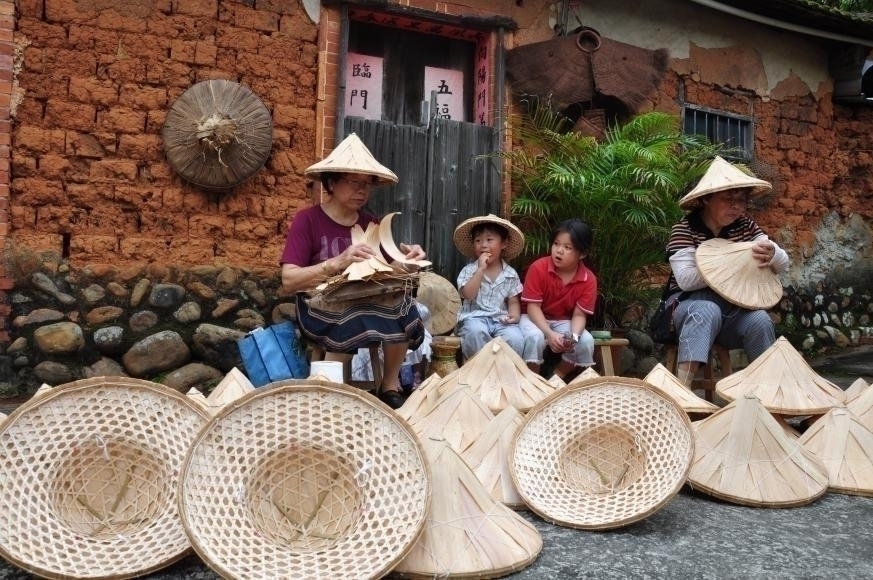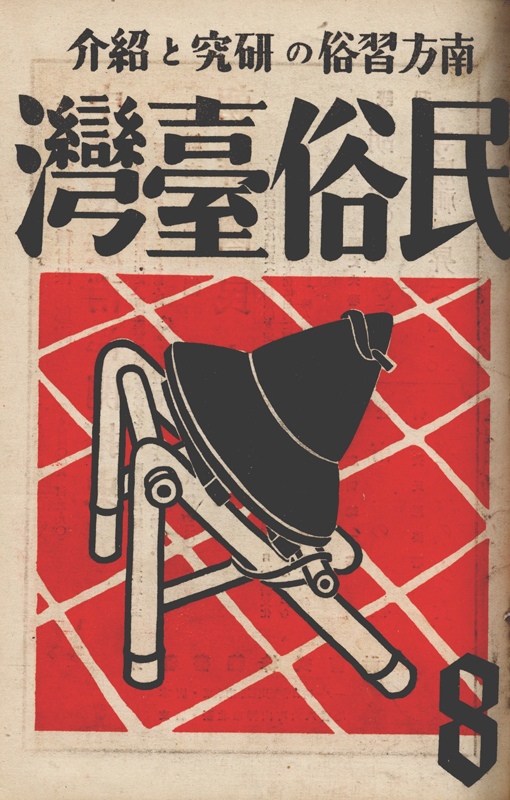Prologue 
Jianghu Entertainer on Upper Beipu Street It is a framed photo taken from above. A crowd of onlookers gather in a circle with their eyes fixed attentively on the male entertainer in the center of the photo‚ waiting to see the new tricks he is about to perform. Within the flow of time‚ the blurred faces of the crowd‚ the clothes people wear‚ the scenes around the street‚ and the ongoing event were all captured in this frame‚ quietly revealing an instant during the 1930s on Beipu Steet in Hsinchu. Inside the image‚ something particular catches people's attention; among hundreds of onlookers‚ dozens of them either wear or hold the bamboo hats. Such scenery can no longer be seen now. With Tropic of Cancer passing across‚ Taiwan has a fierce and hot summer that makes people feel dizzy under the sun. In the afternoon‚ dark clouds gather and the sky becomes black with thunder to be seen. The northwest rain pours beyond expectation‚ but suddenly the rain stops and the sun comes out again‚ bringing out clear blue sky with clouds dissipating. In the early days when plastic rain gears weren't invented‚ bamboo hats and straw rain caps were the best choices to keep out rain and wind. Bamboo hats were light and easy to use. They can be used to prevent people from the heat and the rain‚ making them become daily necessities for Taiwanese people working and walking outdoors. Fabrication of Bamboo Hats Besides bamboo being the main material‚ some hats were also woven and made by Fan Palm leaves. Bamboos are produced in Taiwan. In the past‚ when women were free from the farm work‚ they would use local materials‚ pick up bamboo leaves or bamboo sheaths (bamboo bark‚ or bamboo shells)‚ and spread them out to dry in the sun for the reserve. The bamboos would be cut into bunches and piled in a corner outside the house. After finishing the farm work and housework‚ they would sit separately at the front door of their houses‚ chatting about daily trivial things while they continue to cut open bamboo battens and weave them into bamboo hats. This became a special scene in the countryside. The common way of making bamboo hats is to shape bamboo battens with similar length and width on the wooden mold of the bamboo hat. The next step is to fine and closely weave into the skeleton “the frame of the Bamboo Hat” from the top to the brim of the hat‚ then cover the top of the frame of the bamboo hat with layers of bamboo leaves or bamboo sheaths‚ which is called the step of “Absorbing Bamboo Hat”‚ and finally use the bamboo circle to bind up the top of bamboo leaves and fasten bamboo leaves by sewing them with thin threads which are called “the Thread of Pulling the Bamboo Hat”. Then a bamboo hat is completed.  |   |  |   |  | 
|  | | The scene of Bamboo hats weaving in Luzhu Taoyuan.
(小芬 攝)
| | The steps of Bamboo hats weaving.
| | The wooden mold of the bamboo hat on the cover of the magazine Folk Taiwan issued in August 1943 is drawn by the painter Tateishi Tetsuomi. | | The bamboo-hat-shape lampshade made by “the frame of the Bamboo Hat” having both creativity and a sense of beauty.
(i 攝) |
Selling of Bamboo Hats 
How to sell woven bamboo hats? The images under the lens of the senior photographers give the answer. At noon‚ vendors wearing bamboo hats carried shoulder poles with a bunch of donut-like bamboo hats to peddle along the street. Even though their shoulders were heavily loaded with the burden of life‚ they managed to move on. They sometimes rode bikes instead of walking with two bunches of bamboo hats hung on the back‚ striving to step on the pedals and peddle loudly for the public to come and buy. The figures with dripping sweat depicted one trace after another on the street‚ and chiseled solemn appearances of living day by day.
Nowadays‚ the vendors selling bamboo hats can't be found anywhere‚ but you can still find bamboo hats in stores selling retro tools and utensils made of bamboo‚ rattan‚ wood on the old streets with the same appearance throughout Taiwan. Such stores have been there since Japanese Colonial Period and are commonly called “Grocery Stores of Bamboo Products” (tik-bi̍h-á-tiàm). The stores have various bamboo products‚ including bamboo hats. Hardware stores opened for a long time on the corner of the street may also have some in stock. The bamboo hats are piled up respectively based on their sizes and they are placed in the corner of the stores. If people ask the store-owners whether the bamboo hats are made in Taiwan‚ the store-owners will usually say that most of them are made in Vietnam‚ and only few are made in Taiwan with those being left unsold. . . .
Figures Wearing Bamboo Hats on the Island
 Among misty rain‚ “Fishermen wear straw rain caps when they're spearing fishes; farmers wear bamboo hats when they're cutting rice.” Fishermen and farmers wearing straw rain caps and bamboo hats were common images when ancient intellectuals praised natural rural scenery in song. Bamboo hats and straw rain caps sometimes became the synonyms for fishermen and farmers. After plastic were invented‚ light plastic raincoats replaced heavy straw rain caps‚ and straw rain caps were seen as collection items rather than as practical tools. Bamboo hats gradually left people's lives and are now usually hung on the walls of folk museums or reminiscent restaurants. Among misty rain‚ “Fishermen wear straw rain caps when they're spearing fishes; farmers wear bamboo hats when they're cutting rice.” Fishermen and farmers wearing straw rain caps and bamboo hats were common images when ancient intellectuals praised natural rural scenery in song. Bamboo hats and straw rain caps sometimes became the synonyms for fishermen and farmers. After plastic were invented‚ light plastic raincoats replaced heavy straw rain caps‚ and straw rain caps were seen as collection items rather than as practical tools. Bamboo hats gradually left people's lives and are now usually hung on the walls of folk museums or reminiscent restaurants.Bamboo hats still exist and gain huge popularity among labor workers working outdoors for a long time because they are cheap‚ light‚ portable‚ and the wide brims can keep out rain and heat. Whether it’s on the street‚ in the field‚ beside the mountain‚ on the seashore‚ or in woods‚ you can see the figures wearing bamboo hats everywhere on the island. The melancholy shadows under bamboo hats blur the faces of farmers‚ woodsmen‚ fishermen‚ vendors‚ and the dependable working figures stand out even more in hot and rainy days. The Royal Crown of the Ordinary People Rich in fertile soils and rain during all seasons‚ Taiwan nourishes pieces of green bamboos. Generations grow in company with bamboo leaves dancing and flying under the clouds. People can appreciate the bamboos‚ eat the bamboo sprouts‚ and make use of the bamboo shafts. People always live with the bamboo fragrance floating in the air. Among them‚ bamboo hats obtained from natural fine bamboos are woven by the hands of craftsmen forming simple and firm shapes. Bamboo hats accompany ordinary people every day with features of low profiles and quietness. They are combined with natural wind‚ soils‚ quality materials‚ a sense of beauty‚ traditional skills‚ shinning obscurely inside and can withstand the test of time. The symbolic meaning of bamboo hats could be seen in the naming process of the local poetry Li founded in June‚ 1964 and still issuing up to now. The poet Heng Tai Lin proposed to name the poetry “Li” (bamboo hats). “It reminds people of the comparison between “the crown” and the bamboo hat. The simplicity‚ honesty‚ natural beauty‚ generality‚ and the perseverance of fearing no sun and rain of bamboo hats is symbolic of the people on the island being hardworking‚ free‚ and their indomitable will”‚ said Mr. Lin. From here‚ we can see that compared to the dazzling crown‚ “bamboo hats” bear the clear image of being regular‚ life-related‚ labored‚ and the characteristic of being perseverant in deluges and hot days. In the fast changing pace of modern life‚ people should re-face the bamboo hats and considere them as living utensils‚ crystals of handicrafts‚ and the crown of the regular people. Observe the subtle interdependent relationship through linking things to people and the nature. Through the images‚ you stand at present and communicate with the past‚ catching not only the memory once forgotten‚ but also the value of people's living attitude and labor left behind in reality.
Please refer to the Chinese version for more imges: http://cyberisland.teldap.tw/theme_blog_content.php?op=view&id=145&cid=4 |